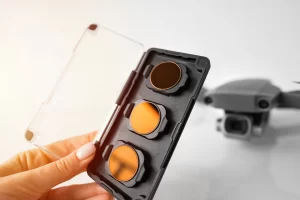Filters serve as indispensable tools in the realm of Augmented Reality (AR), Virtual Reality (VR), and Mixed Reality (MR), enhancing the visual experience and making it more realistic.
With respect to AR/MR/VR applications, there are two major areas in which filters plays a significant role:

Among the category of filters, there exist many different types with widely varying purposes. Here are a few of the most common examples of how filters are used in these fields:
Color Filters
The application of color filters within AR/VR/MR technology is instrumental in enhancing the vividness of virtual environments. By selectively amplifying specific hues, such as applying a red filter to accentuate the red tones within a virtual scene, color filters breathe life into the virtual experience.
Shanghai Optics’ distinct approach to color filters involves high quality absorption filters made of colored glass, which allow certain wavelengths of light to pass through unimpeded, while blocking other wavelength ranges to a designated extent. In contrast to color filters consisting of thin film coatings, Shanghai Optics’ glass filters rely on the absorption and transmission attributes of the colored glass, the precision of which can be achieved through the careful control of the material’s thickness and the concentration of the color used. These colored glass filters are often categorized as longpass, shortpass, or bandpass.
Neutral Density Filters
Neutral density filters are a common tool used to reduce the amount of light entering an AR/MR/VR device, which can help prevent eye strain and improve overall user comfort.At Shanghai Optics, we produce high quality neutral density filters for visible light, as well as for ultraviolet and infrared applications. Our neutral density filter kit provides a set of filters with varying optical densities that can be used either separately or in stacked configurations. Another filter option often used where imaging with a wide range of light transmission is required are stepped optical filters, also known as stepped neutral density filters, which are designed to provide a discrete range of optical densities on a single filter.
Anti-Reflective Coatings
The technical designs of AR/VR/MR devices, often consisting of multiple lenses and screens, can inadvertently introduce reflections and glares that distract from the immersive experience. The use of anti-reflective coatings on these surfaces reduce such reflections and improve image clarity.
Shanghai Optics uses two primary categories of coating: physical vapor deposition (PVD) and chemical vapor deposition (CVD). PVD encompasses techniques involving the deposition of material onto a substrate through physical means such as thermal evaporation and electron beam evaporation. Conversely, CVD is a technique that involves the deposition of a thin film of material onto a substrate by chemical means, such as plasma-enhanced CVD, low-pressure CVD, and etc.

Anti-Reflective Coatings
Polarizing Filters
Polarizing filters are applied to AR/MR/VR designs in order to reduce glare and improve the contrast within the virtual environment. As such, this feature becomes especially practical in outdoor settings or bright environments where glare can pose a challenge. One of our specialties at Shanghai Optics is polarizing coating, which is formed either of a very thin film of birefringent material or by means of interference effects in a multi-layer dielectric coating. If desired, polarizers can be designed to work with an incidence angle of 45 degrees, leading to a beam reflected at a 90 degree angle. Under specific conditions, these coatings can even supplant polarizing prisms in optical assemblies.

Polarizing Filters
These examples merely scratch the surface of the ways filters are applied to AR/VR/MR technology. There exists a wide range of filters and applications in the field of AR/VR/MR, depending on the specific device and the requirements of the user.
Please contact us if you’d like to schedule a free consultation or request a quote on your next project.